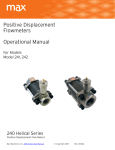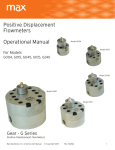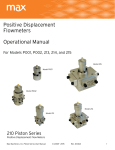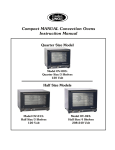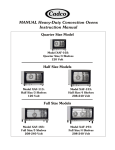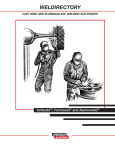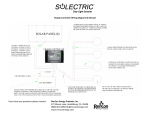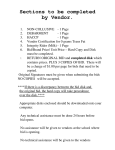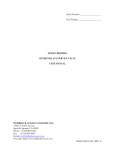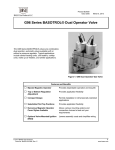Download Positive Displacement Flowmeters Operational
Transcript
Positive Displacement Flowmeters Operational Manual For Models Model 241, 242, 243 240 Helical Series Positive Displacement Flow Meters Max Machinery, Inc. 240 Series User Manual © Copyright 2013 Rev. 002Q4 1 Table of Contents Before You Install....................................................................page 3 Meter General Description....................................................page 4 Transmitter General Description ....................................... page 5 Meter Specifications...............................................................page 6 Transmitter Specifications Analog........................................................................................page 7 Transmitter Specifications Frequency (Pulse)....................................................................page 8 Do and Don’ts...........................................................................page 9 Installation.............................................................................. page 10 Piping Diagrams.......................................................................page 11 ANSI FlangeANSI Flange Stud Torque..............................page 12 Operation.................................................................................page 13 Troubleshooting..................................................................... page 16 241 Helical Flow Meter...........................................................page 17 242 Helical Flow Meter......................................................... page 18 243 Helical Flow Meter......................................................... page 19 Contact for Repairs & Calibration Services......................................................... page 20 Custom Instructions for Hazardous Locations/Explosion Proof Housing: http://www.maxmachinery.com/content/explosion-proof-installation-instructions DO NOT ATTEMPT TO INSTALL OR START FLOW METER WITHOUT READING THIS ENTIRE MANUAL Max Machinery, Inc. (MMI) reserves the right to make changes to the product in this Instruction Manual to improve performance, reliability, or manufacturability. Consequently, contact MMI for the latest available specifications and performance data. Although every effort has been made to ensure accuracy of the information contained in this Instruction Manual, MMI assumes no responsibility for inadvertent errors. Max Machinery, Inc. 240 Series User Manual © Copyright 2013 Rev. 002Q4 2 Before You Install Thank you for choosing to install a Max Machinery precision flow meter. To ensure the best experience please take a moment to read through this manual prior to installation. When you purchased this meter a flow engineer helped determine many of the factors that will be reviewed on the following pages. You may find it useful to fill out the form below and keep it in your files for reference. When you are ready to do the installation there will be a few tools you will need: Meter Installation: The meter and transmitter A signal cable (available from factory) The display or signal processing device Indicator Manual Calibration Certificate Bypass plumbing supplies Many Max meters are installed and operate for decades, so having the following information in your records may prove useful. We have provided this outline as a starting point. Process Temperatures ____________________________ Fluid Viscosity_____________________________________ Operating Range _________________________________ Line Pressure_____________________________________ Max Sales # or PO #______________________________ Installation Date___________________________________ Meter Model # ___________________________________ Meter Serial #_____________________________________ Transmitter Model #______________________________ Transmitter Serial #________________________________ Notes: ______________________________________________________________________________________________ ______________________________________________________________________________________________ ______________________________________________________________________________________________ ______________________________________________________________________________________________ Max Machinery, Inc. 240 Series User Manual © Copyright 2013 Rev. 002Q4 3 Meter General Description The Max 240 Series Flow Meters are positive displacement helical rotor type units capable of precise measurements over a wide range of flow rates and fluid viscosities. inlet outlet The three sizes of this series (241, 242, and 243) will measure flows from 0.1 L/min to 1400 L/min. Material viscosities between 3 and 1,000,000 centipoise may be accommodated. In a helical rotor type flow meter, a precise amount of the fluid being measured is trapped between the rotors as they turn. This motion is used to turn a gear coupled to a magnet. An external transmitter senses the motion of the magnet and converts this signal into a voltage, pulse or 4-20 mA current flow rate output. For some transmitter models, the magnet is eliminated and the motion of the gear itself is sensed. The Max Series 240 Meters are of simple and rugged construction. They can be expected to perform superbly if treated within the confines of the design envelope. For this reason, it is important to read this manual and understand the operational requirements and limits of the meter. Our Technical Service staff will be happy to answer any questions that this manual does not cover. Helical Model 241 with transmitter attached Max Machinery, Inc. 240 Series User Manual Helical Model 242 © Copyright 2013 Helical Model 243 Rev. 002Q4 4 Transmitter General Description Max transmitters are designed to work with the entire family of Max Flow Meters to provide extremely precise flow measurement in a cost effective package. Different options of industrial housings or IP66 rated explosion proof enclosures, combined with a choice of one-part and two-part, high temperature designs with remote electronics cover a wide range of application environments – from the laboratory to harsh industrial processes. This latest generation of transmitters use modern sensor technology coupled with advanced signal processing to deliver high levels of performance and reliability. Hall sensors are used to detect the position of a driven magnet inside a Max Flow Meter. Changes in position are tracked by a microprocessor, which generates an output proportional to the flow rate. Advanced signal processing provides both fine angular resolution (0.36 degrees rotation) and rapid response (output updated every one millisecond). Max transmitters are typically mated to a mechanical flow meter, configured, and calibrated at the factory as a set. This ensures accuracy and allows quick setup in the field. For field installations where the transmitter has not been set up with a meter at the factory, an optional serial interface kit may be purchased to give full access to configuration options and parameters. Transmitter Features High resolution measurement – Analog Output: Configured output ranges to any value within ± 10 Vdc or ± 20 mA. Frequency Output: Configured output resolution of 1 to 1000 pulses per revolution. Linearization of up to 16 points to fully describe the flow meter’s output curve and achieve the highest system linearity over the meter’s entire operating range. Compensation Algorithm – Compensates for variations in Hall sensor and flow meter characteristics to provide a stable, undamped output that accurately represents the instantaneous flow rate. This feature is factory set when the meter and transmitter are mated together. If the transmitter is changed, the compensation can be performed via a button on the circuit board. Anti-Dither Buffer - Masks the false output that may occur at very low flow rates in the presence of vibration or hydraulic noise. If the meter reverses direction the output signal will be interrupted for a user selected portion of a meter rotation. Reverse flow exceeding the buffer setting will result in an output proportional to reverse flow rate. The buffer quantity can be set from 1% to 100% of a revolution. Ex Proof Housing Model 289 Model 295 Analog/ Frequency Max Machinery, Inc. 240 Series User Manual © Copyright 2013 Rev. 002Q4 5 Meter Specifications Model 1 Maximum flow rate, Gal/min Liters/min Maximum pressure, bar (psi) Standard NPT 600 lb ANSI RF flanges 1500 lb ANSI RF flanges 2500 lb ANSI RF flanges Pressure drop, bar (PSI) Operating maximum Absolute maximum 100% flow, 3 CPS 2 Maximum temperature 3 Recommended filtration Displacement, L/Rev Weight, Kg (Lb) 4 Typical K-Factor, (pulses/liter) 295 Transmitter 289-700 Transmitter Port size NPT ANSI RF flanges 241 242 243 50 189 140 540 370 1400 35, (500) 105 (1500) --- 245 (3500) 35, (500) 105 (1500) 245 (3500) --- 35, (500) 105 (1500) 245 (3500) --- 10 (150) 21 (300) 1 (14) 7 (100) 5.3 (75) 15 (200) 10 (150) 0.7 (10) 0.7 (10) Up to 265° C (500° F) 150 micron 0.062 0.182 0.574 13.6 (30) 18.2 (40) 45.5 (100) 15000 403 5000 219 1500 58.8 1.5” 1.5” (DN40) 2.5” 2.5” (DN65) 3” 4” (DN100) Notes: For viscosities of 3 CPS or less. Derate per pressure drop curves for higher viscosites. Limited by meter seal material, transmitter model, orientation and ambient temp. See manual. Consult factory. 3 Some materials may have different filter requirements. Consult factory 4 Typical. See flow meter/transmitter calibration sheet for actual K-factor and accuracy data. 1 2 Max Machinery, Inc. 240 Series User Manual © Copyright 2013 Rev. 002Q4 6 Transmitter Specifications Analog Supply Voltage 12 Vdc 24 Vdc (Models 29X-XXX-100) (Models 29X-XXX-000) Supply Current 90 mA max@ 12 Vdc, 45 mA max@ 24 Vdc Short Circuit Current 21 mA 1 Output Update Rate 1 ms Adjustable without recalibration to any range of ± 10 Vdc Model 29X-3XX-XXX or ± 20 mA Model 29X-2XX-XXX Resolution Ambient Temperature Range Transmitter (Storage)–40ºC to 85ºC (–40ºF to 185ºF) Transmitter (Operation)–40ºC to 80ºC (–40ºF to 175ºF) 2 Maximum Temperature, Process Fluid For explosion proof models see: http://www.maxmachinery.com/content/explosion-proof-installation-instructions (20ºC Ambient, 5V supply) Standard Model 90ºC (195°F) – Models 295 & 296 High Temp Model – Model 296 Ultra-High Temp Model 225ºC (435°F) – Models 295 & 296 Anti-dither Range Software selectable from 1-100% of 1 revolution. 50% of a meter revolution - unidirectional 2% bidirectional are typical default settings Signal Filtering Software selectable from 1 ms to 64 sec. time constant 1 2 Full step change is subject to signal damping Temperature of metered fluid will affect transmitter temperature, see graph below Model 29X Transmitter Series 120 110 Ambient Temperature °C 100 80 60 295 & 296 Standard 40 296 High temperature 2 part pickup 295 & 296 Ultra High temperature 2 part pickup 20 0 -25 50 150 100 200 225 250 300 Process Temperature °C Max Machinery, Inc. 240 Series User Manual © Copyright 2013 Rev. 002Q4 7 Transmitter Specifications Frequency (Pulse) Supply Voltage Supply Current 5-26 Vdc 25-30 mA typical Output (5.0 Volt Supply) (TTL and CMOS compatible) No Load 2.5K Load to Common 2.5K Load to +5 Volts 0.00 / 4.80 Volts 0.00 / 4.60 Volts 0.25 / 4.80 Volts Short Circuit Current 45 mA Output Impedance 100 Ω Rise/Fall Time 1 Output Update Rate 0.2 μSec 1 ms Min/Max Frequency 0-60 kHz Resolution 1 - 1000 pulses/rev, Single Phase 1 - 500 pulses/rev/phase, Quadrature Ambient Temperature Range Transmitter (Storage)–40ºC to 85ºC (–40ºF to 185ºF) Transmitter (Operation) –40ºC to 80ºC (–40ºF to 175ºF) 2 Maximum Temperature, Process Fluid For explosion proof models see: http://www.maxmachinery.com/content/explosion-proof-installation-instructions (20ºC Ambient, 5V supply) 29X-X0X-XXX Standard Model 90ºC (195°F) 29X-X5X-XXX High Temp Model — 2 part model 225ºC (435°F) Anti-dither Range Software selectable from 1-100% of 1 revolution. 50% of a meter revolution - unidirectional 2% bidirectional are typical default settings Signal Filtering Software selectable from 1ms to 250ms time constant 1 2 Full step change is subject to signal damping Temperature of metered fluid will affect transmitter temperature, see graph on previous page Max Machinery, Inc. 240 Series User Manual © Copyright 2013 Rev. 002Q4 8 Do and Don’ts DO: Install bypass plumbing around the flow meter. This is useful during start up for removing dirt and air from the plumbing or when measuring fluid that may freeze inside the line and need to be remelted before it can pass through the meter. It also allows removing the flow meter for service without disabling the system. DO: Be very careful to keep parts clean during installation or teardown. A little dirt can look like a truckload compared to the 150 micron filtration requirement for series 240 Meters. DO: Clean the filter on a regular basis. Max Machinery, Inc. 240 Series User Manual DON’T: Run water or aqueous solutions not approved by Max through your flow meter because of internal galling. DON’T: Steam clean the meter (bypass or remove the meter if necessary). DON’T: Blow down the meter with compressed air or gas because it may over-speed and damage the meter. DON’T: Remove the Transmitter from the flow meter body. The transmitter is phased to the meter and a measurement error will result. Re-calibration will be necessary; see the transmitter interface software manual. DON’T: Disassemble the flow meter. These are precision devices which require special tools and techniques. DON’T: Turn on the pump in a system filled with material that is solid at room temperature. Wait until the material is completely melted and use the flow meter bypass valve during start up. DON’T: Apply excessive differential pressure across the flow meter as it will cause internal failure (see the pressure drop curves for safe area operation). DON’T: Over pressurize the meter. Maximum pressure is either 35 bar (500 PSI), 105 bar (1500 PSI) or 245 (3500 PSI) depending on model purchased DON’T: Exceed the maximum flow rates for the material viscosity. DON’T: Allow materials which solidify in air to set up in the flow meter. These may be impossible to remove. If the meter needs to be removed for repair and cannot be completely cleaned. Plug the inlet and outlet ports at once. © Copyright 2013 Rev. 002Q4 9 Installation For optimum performance, install the flow meter on the discharge side of the pump, in one of the configurations shown on page 11. The following items and conditions should be considered: Location: Install the flow meter in a clean, dry area if possible. Avoid areas with high vibration levels. Line and Bypass Valves: These valves allow filter cleaning or flow meter removal without completely shutting the system down and draining the lines. They are important for system start up under conditions which could damage the meter, such as: air in the lines, solid materials (at room temperature), high temperature materials, or initial line surges. Filtration: Any dirt present in the system can jam or damage the meter. A 150 micron filter is generally recommended, although materials with very high viscosities may require a coarser filter. For bidirectional flow applications, use a filter on each side of the flow meter. Materials with fibrous or non abrasive particulate matter may have to be run without filters. Follow the recommendation of your Max Sales Engineer or consult Technical Service. Clean Plumbing: Before installing the flow meter, clean the inside of the pipe line with compressed air or steam (especially when using new pipe). Don’t use water, steam, or compressed air on the meter itself! Remove any protective covering from the flanges (if applicable). Pipe Threading: When installing pipe to the flow meter, support the nearest end cap or both end caps (as in a vise). Don’t clamp the flow meter body. This avoids possible misalignment of flow meter components when the pipe is screwed tight. Check for proper flow meter operation by rotating the timing gear through the transmitter mounting hole. It should move freely and without noise. High Temperatures: Use the “Vertical Installation” drawing. This minimizes heat transfer by convection from the flow meter to the transmitter. The transmitter is the most heat sensitive element in the system and the transmitter manual should be consulted for specific limits. Optional heating fluid ports are available for the flow meter to keep it at operating temperature during standby conditions. For substances that are solid at room temperature, these ports are generally required to keep the material molten and flowing through the meter. ANSI Flanges: Using the 241, 242 or 243 meters at pressures greater than 500 psi will also require flanges. See the specifications and bolt torque table on page 12. Max has bolt kits available for flange installations. Max Machinery, Inc. 240 Series User Manual © Copyright 2013 Rev. 002Q4 10 Piping Diagrams Vertical Installation Horizonal One Way Flow Installation Flow VALVE 2 Valve 1 Filter Valve 2 Helical Flow Meter HELICAL FLOW METER Bypass Valve 3 BYPASS VALVE 3 Horizonal Two Way Flow Installation Flow FILTER Valve 1 Filter Filter Valve 2 Helical Flow Meter VALVE 1 Bypass FLOW Max Machinery, Inc. 240 Series User Manual Valve 3 © Copyright 2013 Rev. 002Q4 11 ANSI Flange Stud Torque 240 Series ANSI Flange Stud Torque Requirements. This table shows the minimum torque required for a 2:1 tightening factor at the indicated pressures using zinc plated studs and nuts. These values were calculated using studs with a yield strength of Sy = 75,000 psi. Meter (Flange) Studs Torque For Line Pressure ft-lb (N-m) See notes below Qty Size 500 1000 1500 4 3/4-10 24 (33) 49 (67) 73 (99) 241 (2500# Flange) 4 1-1/8-7 37 (50) 73 (99) 110 (149) 242 (600# Flange) 8 3/4-10 24 (33) 47 (64) 71 (96) 242 (1500# Flange) 8 1-8 31 (42) 63 (86) 94 (128) 243 (600# Flange) 8 7/8-9 53 (72) 106 (144) 159 (216) 243 (1500# Flange) 8 1-1/4-7 76 (103) 151 (205) 227 (308) 241 (600# Flange) Absolute Max Torque ft-lb (N-m) Stress at Max Torque (psi)* 200 (271) 47,904 183 (248) 256 (247) 681 (924) 47,789 200 (271) 47,904 483 (656) 47,822 322 (437) 47,972 965 (1310) 47,802 2500 157 (213) 378 (513) 3500 219 (297) 529 (718) Notes: Using the 241, 242 or 243 meters at pressures greater than 500 psi will require flanges. Max has bolt kits available for flange installations. For unplated non-lubricated nuts and studs, multiply the above torque by 1.5. For lubricated nuts and studs, multiply the above torque by 0.9. For cadmium plated nuts and studs, multiply the above torque by 0.8. *Stress in bolt calculated for thread root diameter. Max Machinery, Inc. 240 Series User Manual © Copyright 2013 Rev. 002Q4 12 Operation Determine that the following parameters of your flow metering system are within specifications for the specific 240 Series Meter being used: Maximum System Pressure (Specifications) Differential Pressure across meter (Pressure Drop Curves) Maximum Flow Rate (Pressure Drop Curves) Metered Fluid Temperature (Sales specification, transmitter manual) If the metered fluid is greater than 80°F (28°C) over ambient, see the “High Temperature Start Up” section. With valves one and two closed, slowly open valve three (bypass) to clear the lines of foreign particles and air. Slowly open the inlet valve (# l). Slowly open the outlet valve (# 2). Completely close the bypass valve. No routine maintenance, cleaning, or lubrication of the flow meter is required. A routine filter cleaning schedule should be established. The system should be shut down if abnormal noises occur or if unusual differential pressures across the meter are encountered. High Temperature Start Up: For fluids above 150°F (82°C) based on 70°F ambient, a special procedure is required to prevent thermal shock and permanent damage to the flow meter. The warm up time is determined by the equation below: TIME (minutes) = connector size (in inches) x (operating temperature (F) -125) 10 —OR— TIME (minutes) = connector size (in inches) x (operating temperature (C) -52) 10 Valves one and two must be closed. Open the bypass valve (# 3) in gradual steps until the bypass piping is stabilized at operating temperature. Open valve one slightly and allow the temperature to stabilize around the flow meter. Valve one can then be opened completely. Open valve two slightly. The flow meter may make unusual noises or bind at this point. Leave the valve at this setting until normal meter operation occurs, at which point valve two can be gradually opened all the way. Slowly close the bypass valve (# 3). Max Machinery, Inc. 240 Series User Manual © Copyright 2013 Rev. 002Q4 13 Electrical Installation - Wiring 290 Series Transmitters Removal note: The transmitter does not need to be removed from the flow meter for any field servicing or adjustments. Normally, the flow meter and transmitter are shipped back to the factory for calibration or service as a unit. If the transmitter needs to be removed from the flow meter for installation, be sure to retighten the transmitter snugly in order to ensure proper sensor alignment. Mechanical Installation 1. The transmitter is attached to the flow meter’s threaded magnet shield. Hand tighten only. (~ 3 ft-lb) 2. The transmitter lid has four thread paths. To realign the cable, remove the lid and rotate up to 180° and retighten using an alternate starting point. Tighten to compress the O-ring seal. Removal 1. Remove electrical connections 2. Unscrew transmitter, using a wrench if necessary. WARNING Installation and removal should only be facilitated by trained personnel Verify transmitter output type (ANALOG or FREQUENCY) before wiring, inappropriate wiring could result in damaging the circuit. Moisture Seal Protection On all models, the housing is designed as a liquid and vapor-tight enclosure. There are O—ring seals at the lid and possibly also the base of the housing — these need to be fully seated. A properly sealed transmitter will prevent the formation of damaging moisture inside the housing. Turck connector Model: The connector is sealed to the lid at the factory and is ready for use. NPT Model: To ensure a moisture-tight seal, apply appropriate sealant to the threads at installation. Wiring ANALOG The electrical connector versions are pre-wired inside the transmitter and ready to accept a mating cable (available from the factory). The liquid-tight, NPT models need to be wired during installation as shown in the table below: Analog 294 NPT model All Other Models Mating Cable Wire Color Turck Pin # Case Ground In-lid Case Blue 3 Common 1 Com Black 4 Power * 2 V+ Brown 1 Signal Output (+) 3 Sig Grey 5 Signal Output (-)** 4 Ret White 2 *Model 29X-xxx-000, 24vdc powered, Model 29X-xxx-100, 12vdc powered ** Signal output is fully isolated: If attached to a true differential input a 10K Ohm pulldown resistor should be installed between (—) and common at the receiving end. Max Machinery, Inc. 240 Series User Manual © Copyright 2013 Rev. 002Q4 14 Electrical Installation - Wiring Wiring FREQUENCY The electrical connector versions are pre-wired inside the transmitter and ready to accept a mating cable (available from the factory). The liquid-tight, NPT models need to be wired during installation as shown in the table below: Frequency Single Phase Case Mating Cable Wire Color Blue Turck Pin # 3 Com Black 4 Power 5-26 Vdc V+ Brown 1 Pulse Output Ph A White 2 N/A NC Grey 5 All Other Models Frequency Single Phase Common Wiring Case Ground Current Sinking* Wiring (models 29X-6XX) V+ PLC V+ 0V Digital Input Out Turck Pin #2 * A current sinking device produces an output pulse which is the opposite of a sourcing device. A positive DC voltage must be applied to the wire running between PhA and your PLC. When the output is triggered, this voltage will be grounded to zero volts. Note: use a 5k ohms resistor to limit the current flow in the signal line. Frequency Quadrature All Other Models Mating Cable Wire Color Turck Pin # Case Ground Case Blue 3 Common Com Black 4 Power 5-26 Vdc V+ Brown 1 Output Phase A Ph A White 2 Output Phase B Ph B Grey 5 Transmitter Turck Connector 4 3 5 1 2 Electrical Installation - Wiring 280 Series Transmitters Wiring The 6-pin connector version is pre-wired inside the transmitter and is ready to accept a mating cable (available from the factory). The Liquid-Tight and NPT models need to be wired during installation as shown in the table below: NPT Models 6-Pin Connector Case Ground Circuit Board Terminal # 1 Mating Cable Wire Color Green A Common 2 Black B Power (+5-24 VDC) 3 Red C Pulse Output 4 White D Max Machinery, Inc. 240 Series User Manual Pin # © Copyright 2013 Rev. 002Q4 15 Troubleshooting Trouble Corrective Action No Flow through meter or high pressure drop across meter Solidified material blocking rotation Heat meter to melt material. Debris blocking rotation Remove meter from line. Flush with an organic solvent or petrochemical. Try to work debris out of the meter. Meter broken If you find damaged parts in the meter, return the meter to the factory for repair. Fluid is passing through the meter, but there is no indication of flow Improper hook-up of transmitter Verify that DC power is present at the PCA. Use a multi-meter to measure the transmitter output independent of the display or PLC. Inspect cabling. Indicated flow does not agree with expected readings Air in the line Air bubbles displace the meter just as a liquid would. If you are over-reporting, verify that there is no air in the lines. Indicator not calibrated properly Verify the K-Factor for the meter in use and compare this value to the setting used in the display. Excessive reverse flow in system Max transmitters have anti-dither functions which can buffer up to 1 revolution of reverse flow. An incorrect flow total can be reported if the pumping causes a flow and ebb of greater than 1 meter revolution. Max Machinery, Inc. 240 Series User Manual © Copyright 2013 Rev. 002Q4 16 241 Helical Flow Meter CONNECTIVITY/DIMENSIONS 9.55" 1.5" NPT (243 mm) 5.44" 2.81” 3.88"* (138 mm) (71 mm) (98 mm) *Add 0.4" (10mm) for high pressure body - Top -TopView View- - - End View view - TYPICAL PRESSURE DROP (Delta P versus Flow rate for various viscosities) Pressure Drop (psi) 140 120 Expected Failure Area Intermittent Duty Area —8 bar 100 80 60 —6 bar Continuous Duty Area —4 bar P 0c 00 10, 40 20 0 —2 bar 0.5 1 2 3 5 P 0c 300 10 20 P 0c 100 30 50 P 100 c 3 cP 100 200 Flow Rate (L/min) Max Machinery, Inc. 240 Series User Manual © Copyright 2013 Rev. 002Q4 17 242 Helical Flow Meter CONNECTIVITY/DIMENSIONS 2.5” NPT 10.85” (276 mm) 5.18”* 4.10” (132 mm) (104 mm) *Add 1.32” (34mm) for high pressure body TYPICAL PRESSURE DROP (Delta P versus Flow rate for various viscosities) 140 Intermittent Duty Area Pressure Drop (psi) 120 Expected Failure Area —8 bar 100 80 —6 bar 60 —4 bar Continuous Duty Area P 0c 00 10, 40 —2 bar 20 0 1 2 3 5 10 20 30 cP 00 30 50 P 0c 100 100 P 300 c 200 3 cP 300 540 1k 2k 3k Flow Rate (L/min) Max Machinery, Inc. 240 Series User Manual © Copyright 2013 Rev. 002Q4 18 243 Helical Flow Meter CONNECTIVITY/DIMENSIONS 3.00” NPT 13.10” (333 mm) 7.53” 6.15” (191 mm) (156 mm) -Top- View Top- View - - End View view - - - End TYPICAL PRESSURE DROP (Delta P versus Flow rate for various viscosities) Expected Failure Area Pressure Drop (psi) 140 Intermittent Duty Area 120 —8 bar 100 —6 bar 80 60 Continuous Duty Area —4 bar cP 00 10,0 40 0 P 0c 300 —2 bar 20 1 2 3 5 10 20 30 50 100 P 0c cP 100 300 200 300 500 3 cP 1k 2k 3k Flow Rate (L/min) Max Machinery, Inc. 240 Series User Manual © Copyright 2013 Rev. 002Q4 19 Contact for Repairs & Calibration Services Your Max 240 Series Meter should be repaired at the factory or under the direct supervision of the Max Technical Service Department. Unauthorized repair work may damage the meter and will void the product warranty. Please make note of model and serial numbers on the flow meter before calling the factory. A return goods authorization number (RMA) will be issued if the flow meter has to be sent back for repair. Max Machinery, Inc. 33A Healdsburg Ave Healdsburg, CA 95448 Phone: 707-433-2662 Fax: 707-433-1818 www.maxmachinery.com Max Machinery, Inc. 240 Series User Manual © Copyright 2013 Rev. 002Q4 20




















